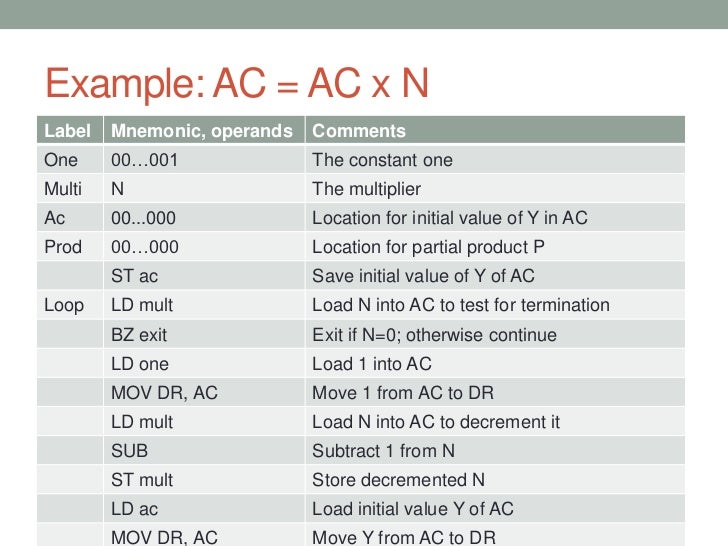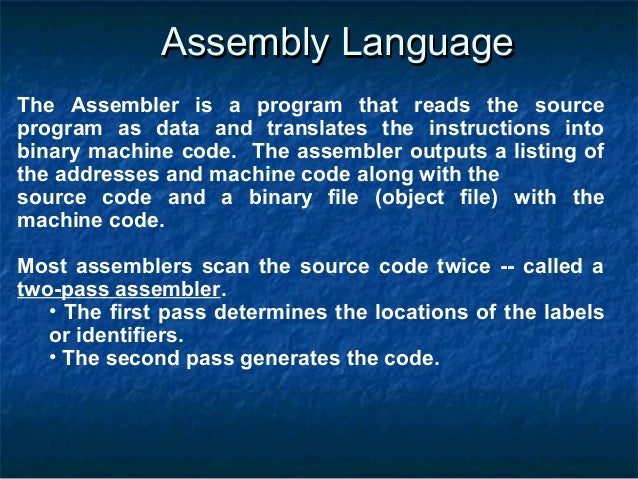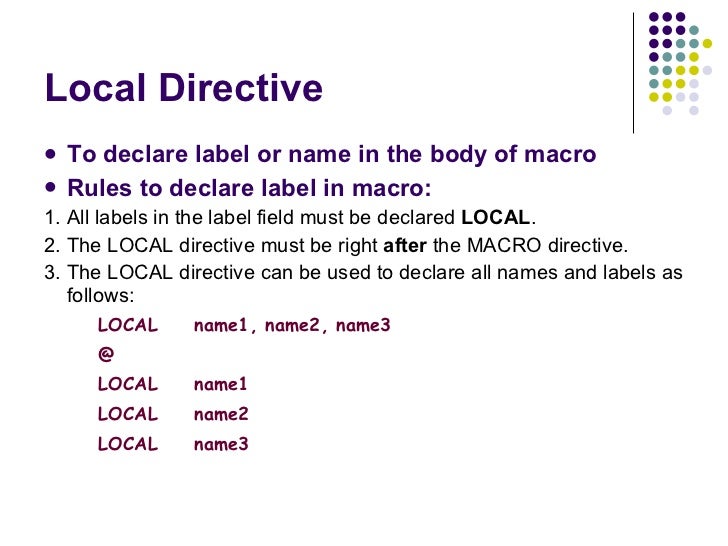41 labels in assembly language examples
Example of Assembly - University of Aberdeen In this example, the assembler would always replace START with 1016. Hence you could write : START EQU 10 ORG START GOTO 10 The assembler would translate START as 10, and load the code at $10, as before. The use of labels often makes a programme easier to understand and to modify. Assembler User Guide: Labels - Keil 7.6 Labels A label is a symbol that represents the memory address of an instruction or data. The address can be PC-relative, register-relative, or absolute. Labels are local to the source file unless you make them global using the EXPORT directive.
flint.cs.yale.edu › cs421 › papersGuide to x86 Assembly - Yale University Addressing Memory. Modern x86-compatible processors are capable of addressing up to 2 32 bytes of memory: memory addresses are 32-bits wide. In the examples above, where we used labels to refer to memory regions, these labels are actually replaced by the assembler with 32-bit quantities that specify addresses in memory.

Labels in assembly language examples
PDF George M. Georgiou Brian Strader In the hello world example, line 7 contains the label "HW." The program uses this label to reference the "Hello World!" string. Labels are also used for branching, which are similar to labels and goto's in C++. Labels are optional and if an instruction does not have a label, usually empty space is left where one would be. PDF Chapter 3 Assembly Language Fundamentals Assembly Language Fundamentals 3.1 Basic Elements of Assembly Language 51 3.1.1 Integer Constants 52 3.1.2 Integer Expressions 52 ... • memory (data label): ex. count Examples of assembly language instructions having varying numbers of operands • No operands stc ; set Carry flag • One operand PDF Assembly Language: Overview - Princeton University • Assembly language! • In between high-level language and machine code! • Programming the "bare metal" of the hardware! • Loading and storing data, arithmetic and logic operations, checking results, and changing control flow! • To get more familiar with IA-32 assembly! • Read more assembly-language examples!
Labels in assembly language examples. PDF Lecture 5 Basic Elements of Assembly Language Data Labels : a data label identifies the location of a variable, providing a convenient way to reference the variable in code. The following, for example, defines a variable named count: count DWORD 100 The assembler assigns a numeric address to each label. It is possible to define multiple data items following a label. 2 Assembly Language Programming - University of New Mexico In an assembly language program, a label is simply a name for an address. For example, given the declarations shown in Example 2.1, ``x'' is a name for the address of a memory location that was initialized to 23. On the SPARC an address is a 32-bit value. As such, labels are 32-bit values when they are used in assembly language programs. PDF Assembly Language NOW, Under21, R2D2, and C3PO are all examples of possible LC-3bassembly language labels. There are two reasons for explicitly referring to a memory location. 1. The location contains the target of a branch instruction (for example, AGAIN in line 0E). 2. courses.cs.washington.edu › mips-asm-examplesMIPS Assembly Language Examples - University of Washington MIPS Assembly Language Examples Preliminaries. MIPS has 32 "general purpose registers". As far as the hardware is concerned, they are all the same, with the sole exception of register 0, which is hardwired to the value 0.
PDF Assembly Language Tutorial 60 00111100 +42 00101010 102 01100110 A negative binary value is expressed in two's complement notation. According to this rule, to convert a binary number to its negative value is to reverse its bit values and add 1. Example: What Is Assembly Language (With an Example) | Indeed.com In this example, "1:" is the label, which lets the computer know where to begin the operation. The "MOV" and "ADD" is the mnemonic command to move the number 3 into a part of the computer processor where it can function as a variable. "EAX," "EBX" and "ECX" are the variables. The first line of code loads 3 into the register "eax." Assembly Language Syntax by Valvano Examples. Assembly Language Syntax Programs written in assembly language consist of a sequence of source statements. Each source statement consists of a sequence of ASCII characters ending with a carriage return. Each source statement may include up to four fields: a label, an operation (instruction mnemonic or assembler directive), an operand ... csiflabs.cs.ucdavis.edu › ~ssdavis › 50AT&T Assembly Syntax | Sig9 Sep 01, 2003 · Updated: May/10 '06. This article is a 'quick-n-dirty' introduction to the AT&T assembly language syntax, as implemented in the GNU Assembler as(1).For the first timer the AT&T syntax may seem a bit confusing, but if you have any kind of assembly language programming background, it's easy to catch up once you have a few rules in mind.
PDF Assembly Language Programming - UTEP - Labels are symbols - Labels must begin in column 1. - A label can optionally be followed by a colon - The value of a label is the current value of the Location Counter (address within program) - A label on a line by itself is a valid statement - Labels used locally within a file must be unique. Adapted from notes from BYU ECE124 5 Jumping to Labels in Inline Assembly | Microsoft Docs Labels defined in __asm blocks are not case sensitive; both goto statements and assembly instructions can refer to those labels without regard to case. C and C++ labels are case sensitive only when used by goto statements. Assembly instructions can jump to a C or C++ label without regard to case. The following code shows all the permutations: LC3 Assembly Language.ipynb - Bryn Mawr College LC3 Assembly Language¶. More abstract, with additional powers: Labels; Instruction and Register names; Assembler Directives.ORIG - location to store code/data.END - end assembly process.FILL - Value for this memory location.BLKW - Block of Words.STRINGZ - Initialize memory with ASCII values, 0-terminated; Shorthand for using decimal and hexadecimal numbers What are Labels in assembly language? - Quora The label is in fact a shorthand for skipping the manual calculation of the number of bytes to add to or subtract from the index pointer, for jump to label means just setting the new place in the memory the execution should continue at, ip+ or - some value.
› ~ed › assembly64x86-64 Assembly Language Programming with Ubuntu - UNLV x86-64 Assembly Language Programming with Ubuntu Ed Jorgensen, Ph.D. Version 1.1.40 January 2020
Assembly Language Style Guidelines - Instructions All identifiers appearing in an assembly language program must be descriptive names whose meaning and use are clear. Since labels (i.e., identifiers) are the target of jump and call instructions, a typical assembly language program will have a large number of identifiers.
Assembly language - Wikipedia Assembly language usually has one statement per machine instruction (1:1), but constants, comments, assembler directives, symbolic labels of, e.g., memory locations, registers, and macros are generally also supported. Assembly code is converted into executable machine code by a utility program referred to as an assembler.
Embedded Systems - Assembly Language - Tutorialspoint The names used for labels in assembly language programming consist of alphabetic letters in both uppercase and lowercase, number 0 through 9, and special characters such as question mark (?), period (.), at the rate @, underscore (_), and dollar ($). The first character should be in alphabetical character; it cannot be a number.
8051 - "Label" in Assembly language - Stack Overflow Label is not bypassed. If you take a look at working of a loop then u will see that first DJNZ decrements the value of register then if the result is non zero it executes the label. In 1st example, starting from above: 1) A gets zero, then. 2) R2 gets 10, then. 3) A gets 25, then. 4) DJNZ decrements the value of R2 making it 9 and since the ...
PDF Chapter 2 HCS12 Assembly Language - TTU CAE Network A line of an assembly program Label field ... 2.1 Assembly language program structure 2.2 Arithmetic instructions 2.3 Branch and loop instructions ... Example: Write a program to add two 4-byte numbers that are stored at $1000-$1003 and $1004-$1007, and store the sum at $1010-$1013.
› 8086-assembly-language-programsKnow Assembly Language Programming of 8086 Simple Assembly Language Programs 8086. The assembly language programming 8086 has some rules such as. The assembly level programming 8086 code must be written in upper case letters; The labels must be followed by a colon, for example: label: All labels and symbols must begin with a letter; All comments are typed in lower case
Compiler User Guide: Assembler labels - Keil Non-Confidential PDF versionARM DUI0375H ARM® Compiler v5.06 for µVision® armcc User GuideVersion 5Home > Language Extensions > Assembler labels 8.36 Assembler labels Assembly labels specify the assembly code name to use for a C symbol. For example, you might have assembly code and C code that uses the same symbol name, such as counter.
Assembly Language Programming • ECEn 323: Computer ... Assembly language is more readable than the binary machine code and is easier to edit and manipulate. The purpose of the "assembler" is to translate the text assembly language file written by a human into binary machine code executed by the processor (See section 2.12 in the textbook). This process is tedious and best left to a computer.
PDF Graded ARM assembly language Examples - AlanClements Anything starting in column 1 (in this case Stop) is a label that can be used to refer to that line. 4. The instruction Stop B Stop means 'Branch to the line labelled Stop' and is used to create an infinite loop. This is a convenient way of ending programs in simple examples like these. 5.

Assembly Language Instructions With Examples | Introduction | C, C++, and Assembly Language ...
pic microcontroller assembly language programming examples For example MOVLW is an Opcode. Labels. A label is an identifier used to represent a line in code or section of a program. Goto statements can be used in conjunction with a Label to jump to the execution of code identified by the particular label. See Task 1 code for example. ... pic microcontroller assembly language examples 6.
› 8051-assembly-language-programmingIntroduction to 8051 Programming in Assembly Language Follow the given rules to write programming in assembly language. Rules of Assembly Language. The assembly code must be written in upper case letters; The labels must be followed by a colon (label:) All symbols and labels must begin with a letter; All comments are typed in lower case; The last line of the program must be the END directive; The ...
gcc.godbolt.orgCompiler Explorer Compiler Explorer is an interactive online compiler which shows the assembly output of compiled C++, Rust, Go (and many more) code.
labels in assembly language examples In example-1, when first time program runs, A gets value 25, and then when R2 decrements from 10 to 1, output is 275 instead of 250. procedures or labels. Provide examples of three different instruction mnemonics. 10/7/2012 GC03 Mips Code Examples Conditional Branch Instructions - using labels calculating offsets is difficult - use a label instead!
Label (computer science) - Wikipedia In assembly language labels can be used anywhere an address can (for example, as the operand of a JMP or MOV instruction). Also in Pascal and its derived variations. Some languages, such as Fortran and BASIC, support numeric labels. Labels are also used to identify an entry point into a compiled sequence of statements (e.g., during debugging ).
Labels (x86 Assembly Language Reference Manual) When a numeric label is used as a reference (as an instruction operand, for example), the suffixes b ("backward") or f ("forward") should be added to the numeric label. For numeric label N, the reference Nb refers to the nearest label N defined before the reference, and the reference Nf refers to the nearest label N defined after the reference.
Assembly Language Instruction - an overview ... Assembly language is a special type of abbreviated language, each symbol of which pertains to a specific microprocessor operation. Some assembly language instructions, such as branch, jump, jump-to-subroutine, and RTS, have already been discussed. Others will be discussed as they are needed to execute an example program.











Post a Comment for "41 labels in assembly language examples"